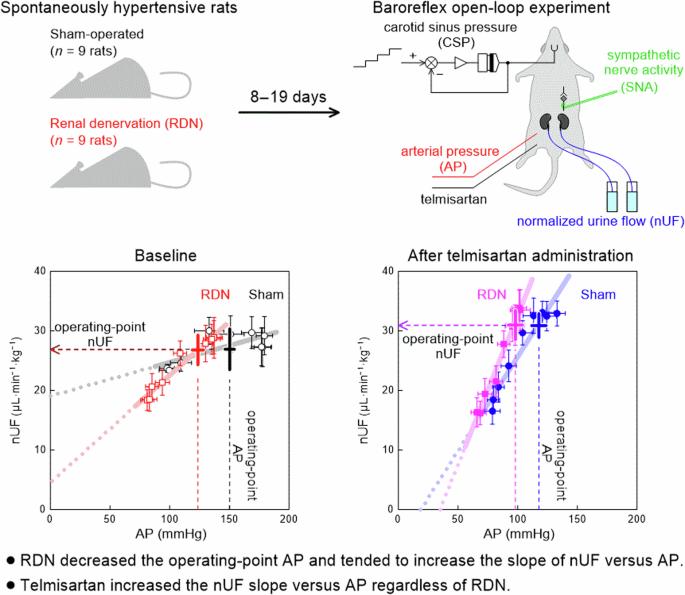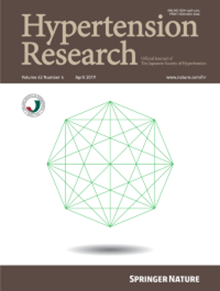双侧肾神经支配对自发性高血压大鼠开环气压反射功能和尿液排泄的影响
IF 4.6
2区 医学
Q1 PERIPHERAL VASCULAR DISEASE
引用次数: 0
摘要
双侧肾脏神经支配(RDN)可降低自发性高血压大鼠(SHR)的动脉压(AP)或延缓高血压的发展,但双侧 RDN 是否会在气压反射介导的急性 AP 变化期间显著改变尿输出功能仍是未知数。我们量化了接受双侧 RDN 的 SHR(9 只)的 AP 与正常化尿流(nUF)之间的关系,并将结果与假手术 SHR(9 只)的结果进行了比较。此外,我们还研究了血管紧张素 II 1 型受体阻滞剂替米沙坦(2.5 mg/kg)对 AP-nUF 关系的急性影响。双侧 RDN 通过缩小颈动脉窦气压反射总弧的反应范围,明显降低了 AP。在基线条件下,假体组和 RDN 组的 nUF 与平均 AP(单位:μL-min-1-kg-1-mmHg-1)的斜率分别为 0.076 ± 0.045 和 0.188 ± 0.039;而服用替米沙坦后,这两个斜率分别为 0.285 ± 0.034 和 0.416 ± 0.078。RDN对nUF斜率的影响略有显著性(P = 0.059),这可能改善了RDN组尿量的可控性。替米沙坦对假性组和 RDN 组 nUF 斜率的影响显著(P < 0.001),这表明无论肾交感神经活动是否持续,循环或局部产生的血管紧张素 II 都有助于决定尿量功能。本文章由计算机程序翻译,如有差异,请以英文原文为准。


Effects of bilateral renal denervation on open-loop baroreflex function and urine excretion in spontaneously hypertensive rats
Bilateral renal denervation (RDN) decreases arterial pressure (AP) or delays the development of hypertension in spontaneously hypertensive rats (SHR), but whether bilateral RDN significantly modifies urine output function during baroreflex-mediated acute AP changes remains unknown. We quantified the relationship between AP and normalized urine flow (nUF) in SHR that underwent bilateral RDN (n = 9) and compared the results with those in sham-operated SHR (n = 9). Moreover, we examined the acute effect of an angiotensin II type 1 receptor blocker telmisartan (2.5 mg/kg) on the AP–nUF relationship. Bilateral RDN significantly decreased AP by narrowing the response range of the total arc of the carotid sinus baroreflex. The slopes of nUF versus the mean AP (in μL·min−1·kg−1·mmHg−1) in the sham and RDN groups under baseline conditions were 0.076 ± 0.045 and 0.188 ± 0.039, respectively; and those after telmisartan administration were 0.285 ± 0.034 and 0.416 ± 0.078, respectively. The effect of RDN on the nUF slope was marginally significant (P = 0.059), which may have improved the controllability of urine output in the RDN group. The effect of telmisartan on the nUF slope was significant (P < 0.001) in the sham and RDN groups, signifying the contribution of circulating or locally produced angiotensin II to determining urine output function regardless of ongoing renal sympathetic nerve activity.
求助全文
通过发布文献求助,成功后即可免费获取论文全文。
去求助
来源期刊

Hypertension Research
医学-外周血管病
CiteScore
7.40
自引率
16.70%
发文量
249
审稿时长
3-8 weeks
期刊介绍:
Hypertension Research is the official publication of the Japanese Society of Hypertension. The journal publishes papers reporting original clinical and experimental research that contribute to the advancement of knowledge in the field of hypertension and related cardiovascular diseases. The journal publishes Review Articles, Articles, Correspondence and Comments.
 求助内容:
求助内容: 应助结果提醒方式:
应助结果提醒方式:


